‘Stories from the future’ – A series of speculative fiction
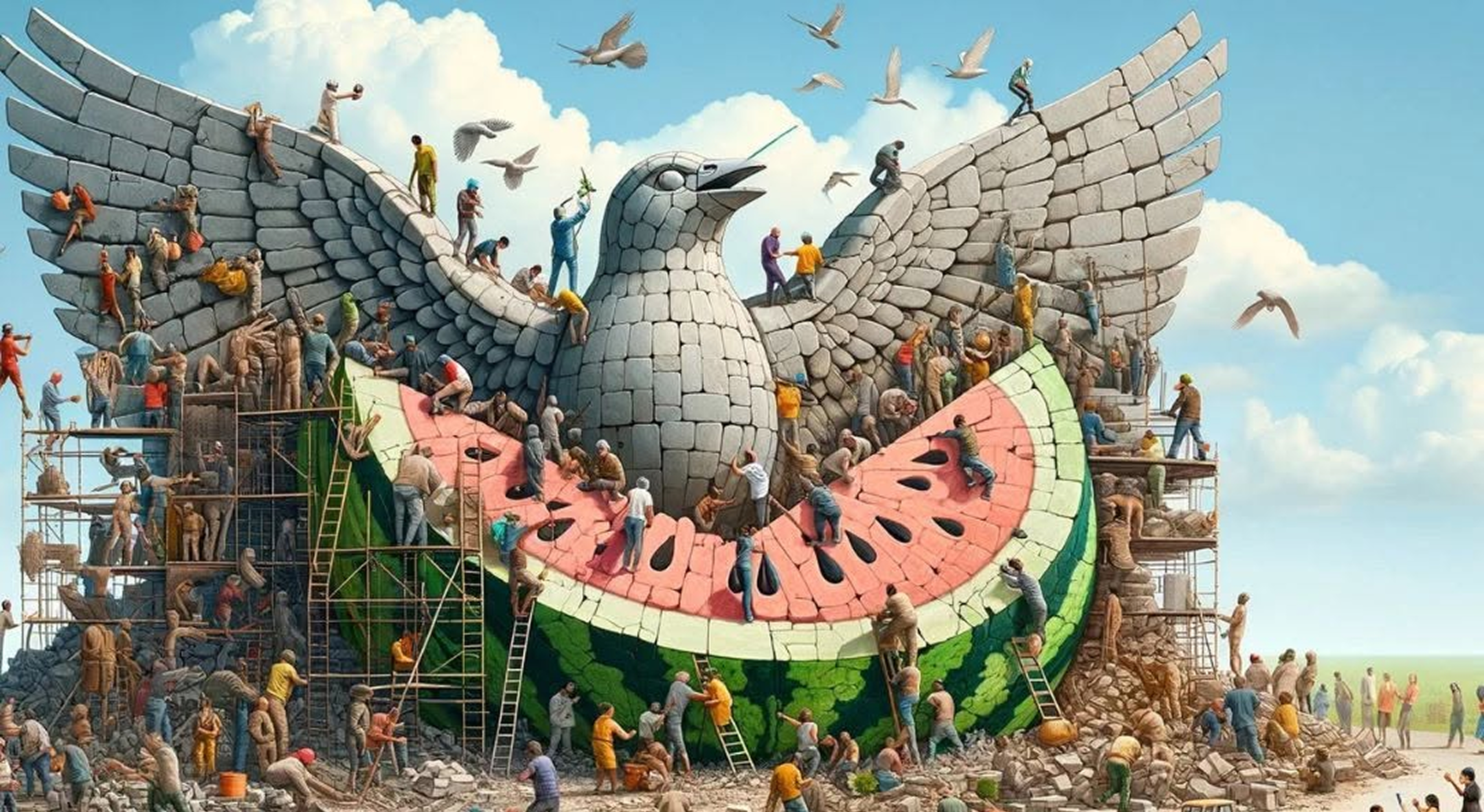
Stories from the Future envisions a world of love, strong communities, and justice through speculative storytelling. It asks us What is the world we are trying to create?
Vidushi Yadav
Stories from the Future
A series of crowdsourced speculative stories, curated by Vidushi Yadav, Stories from the future invite us to envision and craft the world we dream about. It champions the transformative power of active and radical imagination in creation, this series encourages us to lay the foundations for a future that we want our children to have—a future shaped by love, strength in community, empowering narratives and the dissolution of systemic oppression through a collective realization that it no longer has a place in our world.
Love Rebuilds Gaza
A speculative fiction about the transformation of Gaza
The genocide has finally ended, and the silence after the long-standing war in Palestine heralds a new era. This time, it did not end because of diplomatic negotiations or political maneuverings but rather through an extraordinary uprising of the global working class, fueled by the power of social media outrage and a collective realization of power in the collective.
Common people across continents and cultures unite with a singular resolve: to reject the leadership of violent governments and build a world they want their kids to grow up in.
As the dust of war settles and borders fling open, an unprecedented wave of people rush to Gaza, driven by a profound sense of solidarity. From every corner of the globe, individuals—regardless of their means—make their way to Gaza to rebuild what was broken.
It became every person’s business that Gaza gets back on its feet. People came in flights, food trucks, healthcare convoys, and even makeshift rafts become vessels of hope, ferrying those eager to lend their skills, hearts, and hands to the cause. Humanity has never seen something like this.
Gaza transforms into a beacon of global unity, welcoming a strange mix of volunteers: healthcare professionals specializing in trauma, psychologists, world leaders, philosophers, architects, environmentalists, artists, educators, and more. Each person, regardless of their background, contributes uniquely—sowing seeds, preparing meals, caring for the wounded and traumatized, creating art on the remnants of destruction, or simply making music that soothes the soul. People created with whatever resources they could find. The city became the world’s largest DIY project
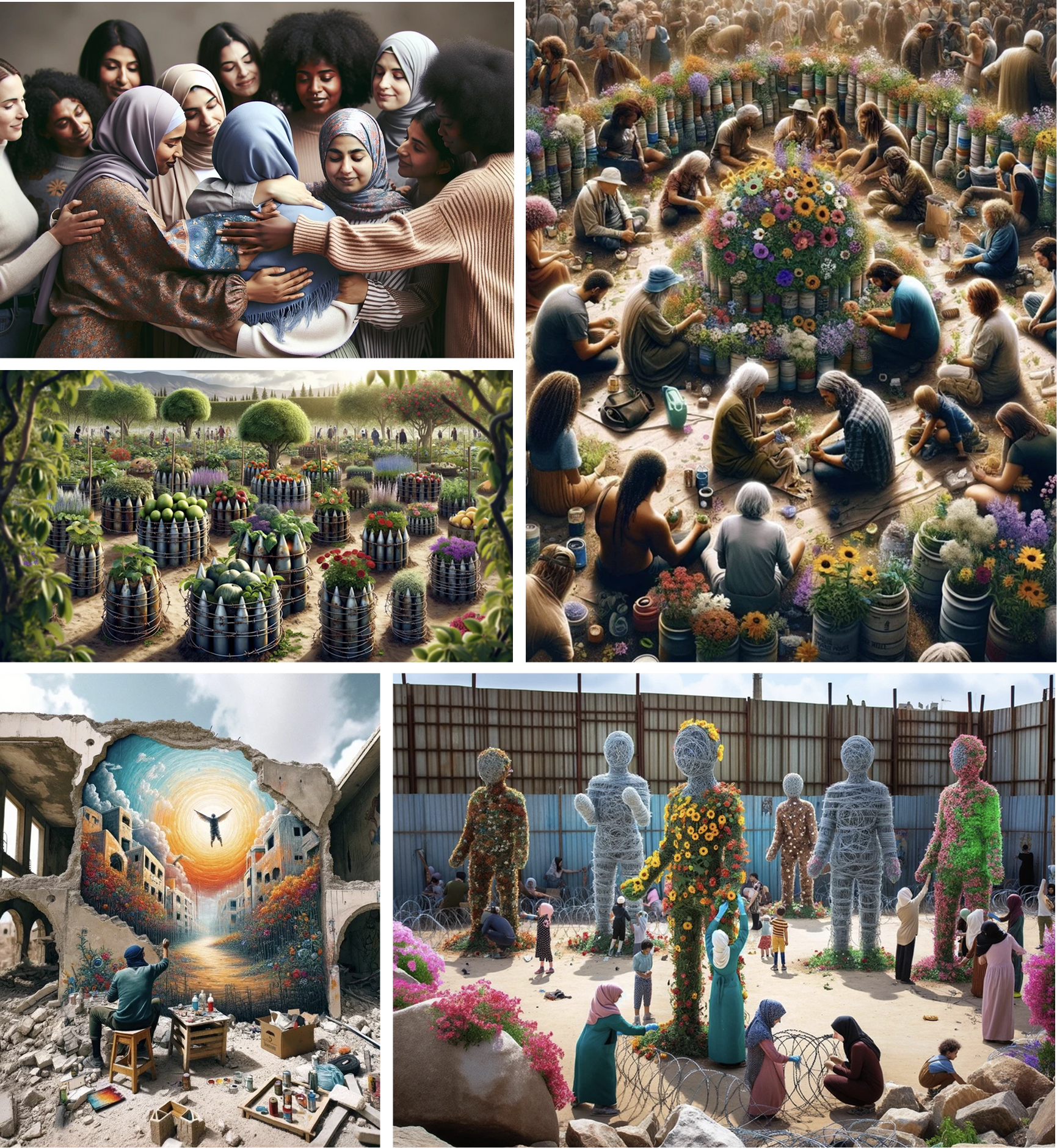
This influx of support kindles a newfound optimism among the people of Gaza, who, after years of despair, begin to envision a brighter future. The act of rebuilding Gaza evolves into a symbol of vogue, the new cool —a testament to the transformative power of collective compassion over the divisiveness of conflict.
People took personal responsibility to re-build Gaza and everyone is amazed to see the creativity and skills of each other. The world leaders, the billionaires and the big-tech had to catch up. They realized that the new world is rejecting the ‘divide and rule’ strategy that have been proven successful for so long. New empowering narratives are re-written.
As Gaza rises from the ashes, it becomes the epicenter of a novel global movement characterized by love, unity, and compassion. A world where the antidote to violence isn’t further aggression but an overwhelming surge of global solidarity. Collective Humanity’s shared values have forged a path to peace, It’s a dawn of an era governed not by geopolitical interests but by an unbreakable bond of collective empathy and cooperation. This is the beginning of something unprecedented— a world where people are aware of the power of collective, a world with compassion and care at the centre and love as the guiding force for the future of humanity.
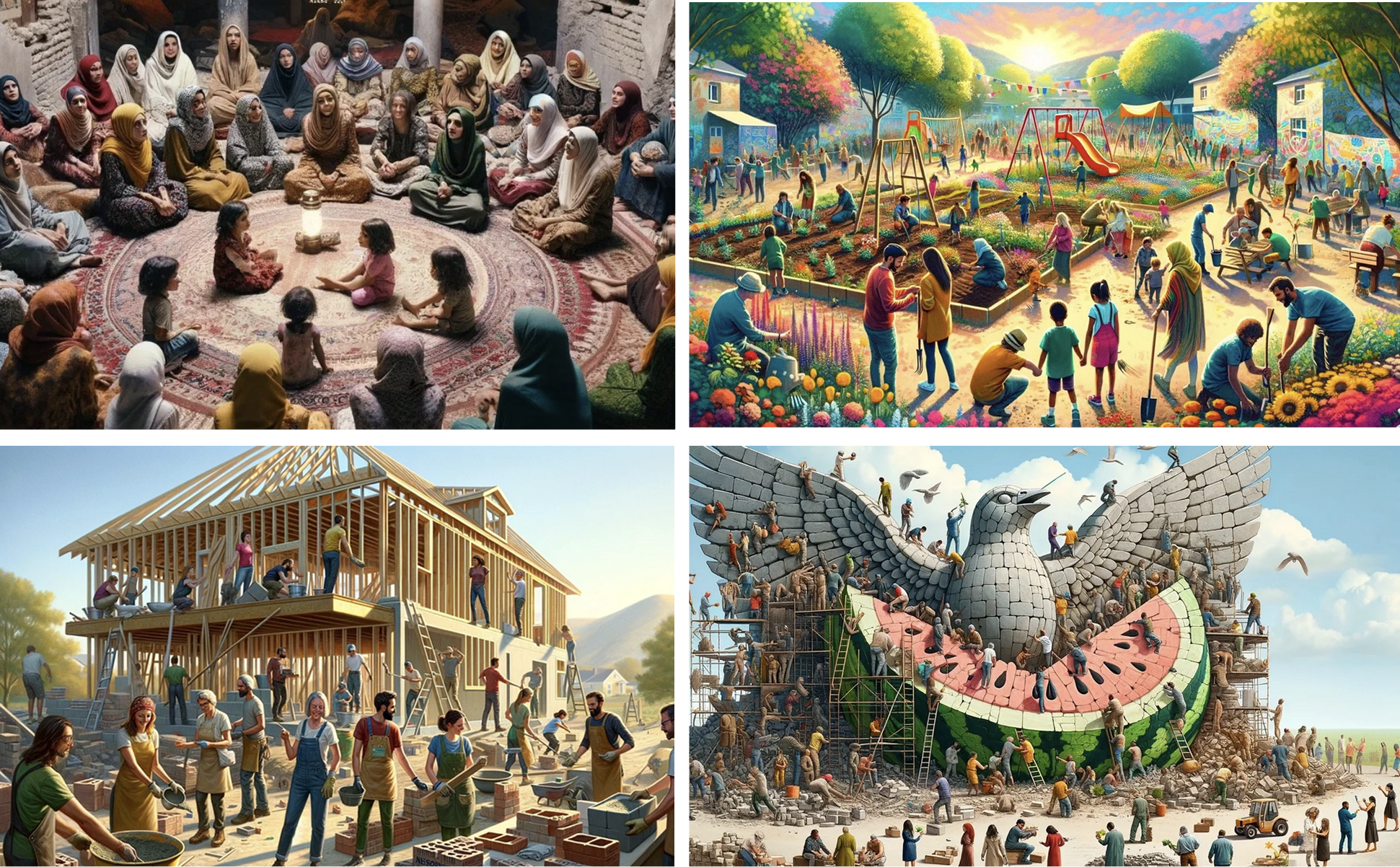
‘We officially left the state of climate emergency’
Story contributed by WECF International
“We officially left the state of climate emergency” scientists communicated on the news. In the squares of all the world, the people were waiting for exactly these, they had made it! They were not mere spectators in the theater of governance anymore but rather architects of their own destiny. The global community stands united, not in fear, but in celebration.
The past months had been a hard journey. It all started with the Gender Just Climate Solutions going viral on the internet, Locally-led, grassroots, concrete examples that center gender justice for feminist climate action.These feminist and transformative solutions spread like wildfire across the world, igniting hope in the hearts of billions. People finally saw an end to the climate crisis that had plagued them for years. The viral movement had opened their eyes to the solutions already in existence, solutions their governments had kept hidden, preferring to maintain their power and wealth, centered on contiuing to grow the economy.
The leaders of this movement spoke of the tireless work they had done on the ground, shared stories of climate resilience and wisdom. They spoke of innovative and creative solutions tackling climate change by sharing indigenous knowledge, providing off-grid solar energy to rural women and communities, improving access to clean water and sanitation facilities and promoting sustainable agriculture practices. They were not just fighting a crisis; they were changing the system and the current narrative.

And the people heard and grew angry, weary of empty promises and hollow rhetoric, and rose. They took to the streets, their voices a thunderous roar demanding a radical shift from capitalism. They were not just protesting; they were demanding and getting a feminist common future. They were tired of being governed by faceless technocrats who cared more about profit than people and the planet.
The leaders had no choice but to listen. They invested trillions in the new Gender Just Climate Solutions leaders, powerful women from the Global South. It was a new dawn, a time of degrowth and local knowledge and leadership, with a bottom-up approach. In this new world, the old ways of capitalism were gone. The focus was no longer on growth at all costs but on values like empathy, buen vivir, care, ubuntu and agroecology. The new leaders were not the titans of industry but these women, who had dedicated their lives to promote their solutions, and were finally heard.
The people had understood that the movement was not just about saving the planet but about saving themselves and what was left of the world’s beauty. It was about recognizing that capitalist societies based on money, competition, exploitation and discriminatory values like white cisheteropatriarchy were destroying them.
And so, the world changed. Countries were no longer relying on burning fossils. Instead, they embraced local agriculture and a circular economy. They lived in a world that was inclusive and just, where the climate emergency was a thing of the past. It had been a long and difficult journey, but they had done it. They had saved the planet, and in doing so, they had saved themselves.
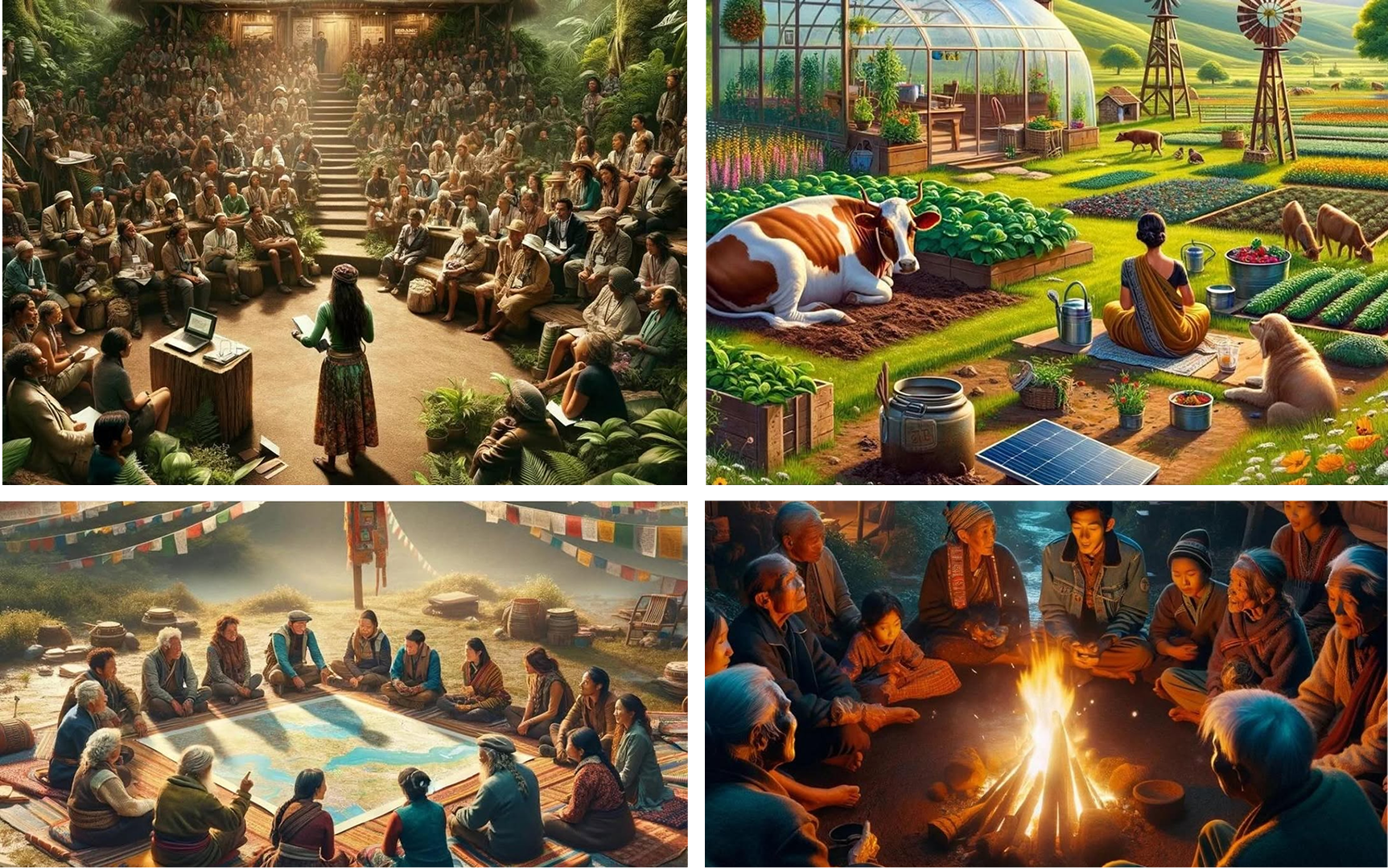
Where businesses serve life in all its forms
Story by larger.world
In the past, we heard that the situation was dire:
Businesses were solely focused on profit without any regard for consequences. They exploited nature and humans in the pursuit for money – the highest form of value in the capitalistic world. Exploitation was particularly present in the low-income world, even resorting to child labour to meet the insatiable demand for consumption.
The world’s wealth was concentrated in the hands of a few, leaving the rest of humanity struggling for survival.
Despite technological advancements, environmental concerns were ignored, leading to the depletion of raw materials and evident consequences such as scorching summers, snowless winters, frequent floods and fires, and the disappearance of many species, risking severe damage to the whole ecosystem.
Fortunately, this bleak era is now behind us.
Businesses have become decentralized, abandoning hierarchies and old-fashioned management practices based on power and command. They stopped all practices harmful to nature and fully embraced ecological products in the production lines. Electricity is now sourced entirely from renewable resources like the sun and wind, ensuring clean air in both urban and rural areas. Factories have phased out plastic and other harmful materials, opting for plant-based and recyclable alternatives. Supply chains are meticulously managed, with most businesses using locally sourced raw materials, resulting in residents primarily consuming products made within their own country.
Businesses are now net-zero on their carbon emissions, and not only that, they do not need to invest in greenwashing any more. Instead, they invest in gatherings and events where the shared responsibility and harm can be discussed, accepted, and faced. Where humans can reconnect with their role as keystone species and enable others to come alive. The era of Sustainability Inc. is over – and there is not need for defining what we mean when we say “green business”, ESG or sustainability. Companies still make profit but profit comes from a regenerative business model that reflects a profound shift towards earth-conscious investment practices and inner compass of responsibility, on a global scale. Companies recognise their entanglement with death and colonialism and are the most innovative pioneers of setting up new systems and examples of collaboration, development and success.
Soil, waterways, and ecosystems are now clear and safe, as businesses in sectors such as agriculture, manufacturing, and mining have stopped harassing the soil and using harmful chemicals that contaminate them.
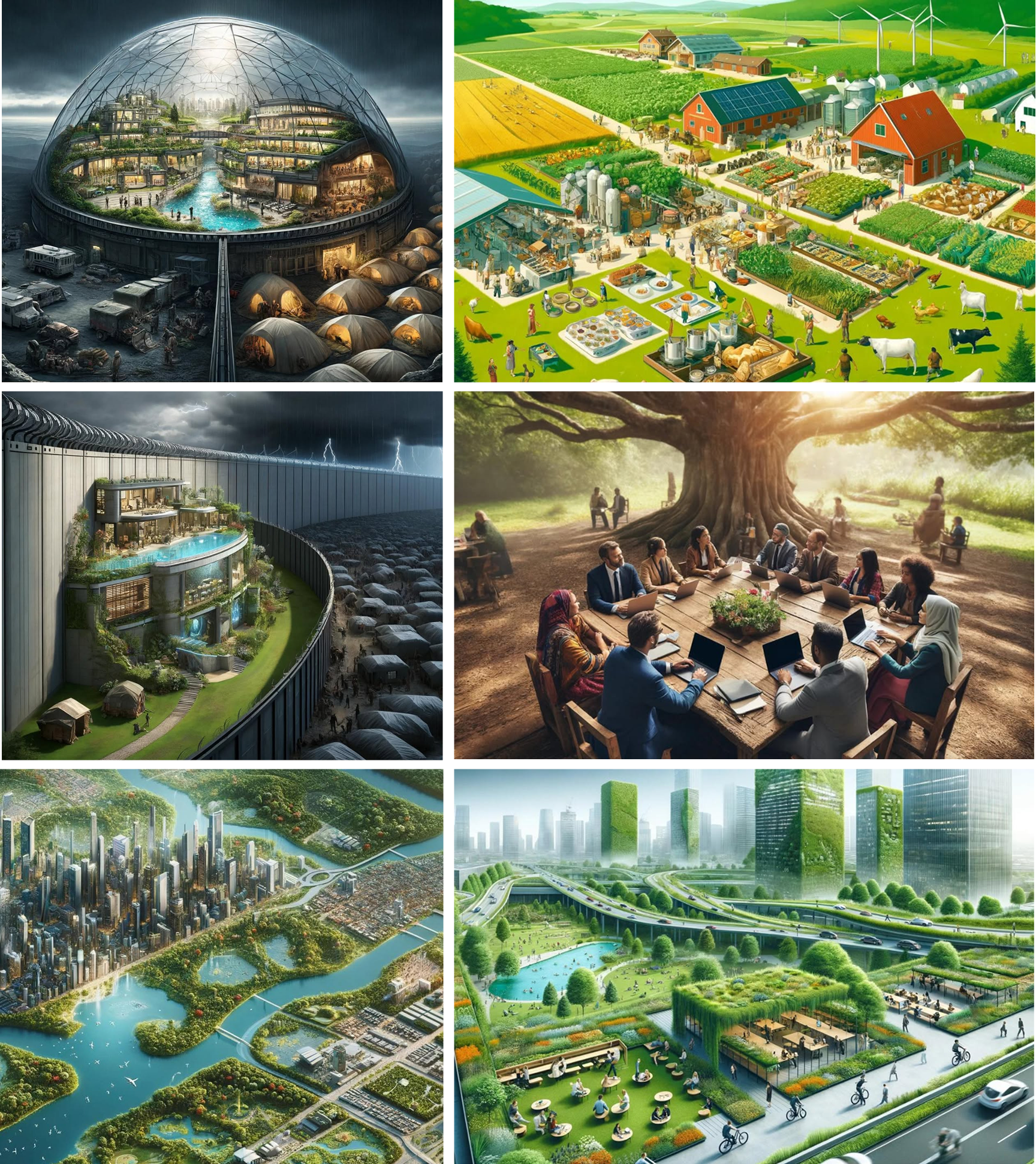
Today, people recognize nature as the primary source of life, preserving forests and green spaces for future generations. Jobs and money are relevant but only as a tool to preserve, heal and reconnect to our role as humans, in the living system of our planet and universe.
Even in urban areas, greenery prevails, with concrete roads replaced by lush green spaces. Rooftops of all factories and companies have been transformed into gardens where employees cultivate organic vegetables. Major roads have been moved underground, facilitating bicycle use in cities and promoting electric cars for longer journeys.
In workplaces, a holistic approach prevails, with decisions benefiting the entire organization rather than specific roles. Sustainability, diversity, inclusion, and equity are no longer departments in a company but shared avenues of trust and ownership and owned by every team member, with each person valued equitably.

Our differences now complement one another, helping us overcome weaknesses without measuring intelligence, as we acknowledge each person’s unique abilities. We prioritize experiences over material possessions, finding happiness in nature and simple gestures like walks and hugs.
Nature is regenerated entirely, rejuvenating both plant and animal life. Companies understand their role in the world as contributors to life, within nature and they learn from the wisdom of indigenous peoples.
As a society, we have come to recognise that true wealth lies in the health of our planet and the well-being of all its inhabitants. The business world serves as a balancing board in what used to be gaps of priveledge and wealth in the world. Through collective action and a shared commitment, businesses continue to pave the way towards a brighter and more resilient future for generations to come.
This series of speculative stories invite us to envision and craft the world we dream about. It champions the transformative power of active and radical imagination in creation, this series encourages us to lay the foundations for a future that we want our children to have-a future shaped by love, strength in community, empowering narratives and the dissolution of systemic oppression through a collective realization that it no longer has a place in our world.
Do you have a story from the future? Write to us at vidushi.yadav@gmail.com.
Our team is eager to collaborate with you to bring your foresights to life, so that together, we can inspire and contribute to the collective vision of dreaming and constructing our shared future.
Submissions can be made anonymously, if preferred.